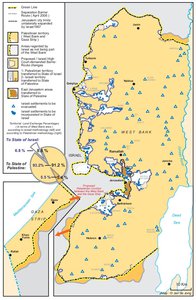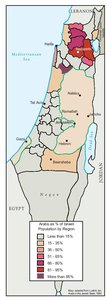THE PALESTINIANS INSIDE ISRAEL, 1977
Map Details
The Palestinians who remained in the area, which became Israel in 1948 found themselves instantly
transformed into an ethnic minority under military rule, stripped of all pre-state economic and political
structure and with their identity denied by the Jewish State. At the close of the war ca. 90,000 Palestinians
remained in the central and western Galilee, ca. 31,000 in the area known as the ‘Little Triangle’ (bordering
the north-western tip of the West Bank) and ca. 13,000 in the Negev. A further 10-12,000 were residing in
the previously ‘mixed’ cities of Akko, Haifa and Jaffa. With the exception of the Galilee’s Nazareth (16,800)
and Um Al- Fahm in the ‘Little Triangle’ (5,000) the remaining Palestinian localities were small hamlets or
villages. About 70% of the Arab community were Muslim, 21% Christian and 9% Druze.
The existence of a 12.5% ‘non-Jewish’ minority was immediately conceived of by the leaders of the Jewish
State as a threat - both in terms of the Zionist imperative of an ethnically exclusive nation and in terms of
the Palestinians’ ‘suspect loyalties’ given the state of regional conflict. Four days after Israel’s 15 May 1948
declaration of independence, the provisional government issued the ‘Defense Emergency Regulations’,
invoking repressive British Mandate laws employed to crush the 1936-39 Revolt. These regulations paved
the way for the creation of a dual, or two-tier, legal administration that placed the Palestinians under military
rule until 1966. Among the first directives issued to the military governors was that to evacuate “semiabandoned
villages.”
The military government was not merely an instrument of physical control, but was used to systematically
erode and counter any efforts by the Palestinians to improve upon their fragmented and isolated status -
both as a community and vis-à-vis Jewish government and society. Some 170 military orders were issued,
limiting the Palestinians' basic rights to property, travel, political activity and freedom of speech. Israel’s
Arab Affairs Advisor described the Palestinians in Israel as, “sworn and everlasting enemies,” and the
military commanders agreed: “they must be checked, patrolled and supervised.”
Israel’s perception of the Palestinians as a ‘demographic threat’ fueled a drive to settle and control areas of
‘non-Jewish’ character. By 1966, when the military government was abolished, 35 post-1948 exclusively
Jewish settlements had been established in the Galilee and over 100 in the Negev area. Many more were
planned. Meanwhile, some 100 Palestinian villages were not even recognized by Israel, which ‘zoned’ them
in ‘non-residential’ areas and has persistently denied them the most fundamental infrastructure and
development. ‘Re-zoning’ later meant that Jewish towns were erected on the land of unrecognized villages,
where they enjoy national development priority status.
Within four decades of the 1948 War at least 80% of the Palestinian minority’s land would be expropriated
by the state. By the mid-1970s, 533,800 Palestinians made up 15.3% of Israel’s population, yet only four of
the 120 members of Knesset were ‘non-Jews’, the adult illiteracy rate among Palestinian women was nearly
60% and under 3% of higher education students were Palestinian. Persistent discrimination, both legal and
de facto, the near total loss of landholdings, and the strengthening of their Palestinian identity following the
1967 War, hastened the emergence of an organized ‘civic struggle’ for rights and equality.
In 1976, with Israel declaring its commitment to “populate the Galilee [with Jews],” so as to, “protect national
land,” and expropriation accelerating, a general strike was called. On 30 March 1976, dozens of committees
and emerging political bodies led a popular protest rally against expropriation in the Galilee. When Israeli
forces attempted to impose a curfew to quell the protests, clashes erupted, in the course of which six
Palestinians were killed. ‘Land Day’ has thereafter been observed annually to commemorate and further the
struggle of the oppressed Palestinian minority against dispossession, discrimination and marginalization.
Related Maps
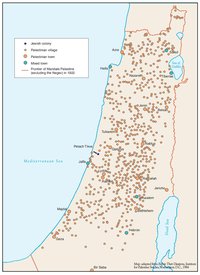
OTTOMAN PALESTINE, 1878
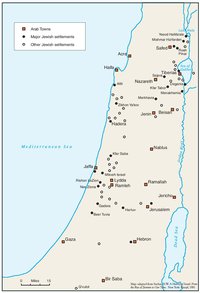
ARAB TOWNS AND JEWISH SETTLEMENTS IN PALESTINE, 1881-1914
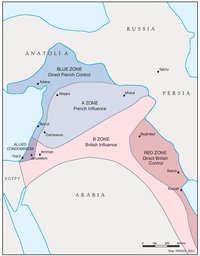
THE SYKES-PICOT AGREEMENT, 1916
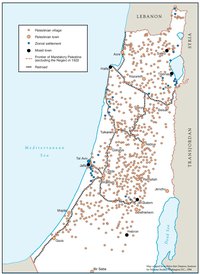
THE BEGINNING OF THE BRITISH MANDATE, 1920
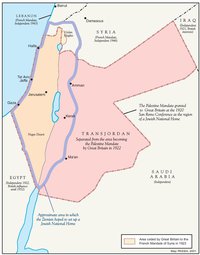
PALESTINE UNDER THE BRITISH MANDATE
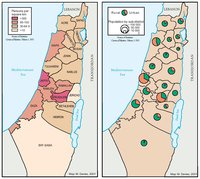
THE DEMOGRAPHY OF PALESTINE, 1931
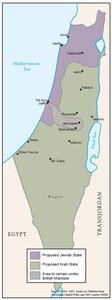
THE PEEL COMMISSION PARTITION PROPOSAL, 1937
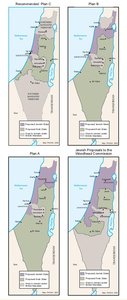
THE WOODHEAD COMMISSION PARTITION PROPOSALS, 1938
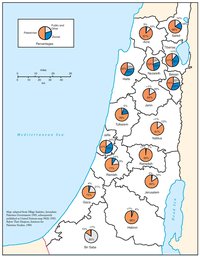
PALESTINIAN AND ZIONIST LANDOWNERSHIP BY SUB-DISTRICT, 1945
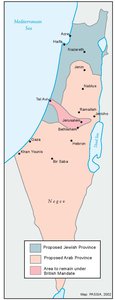
THE MORRISON-GRADY PARTITIONED TRUSTEESHIP PLAN, 1946
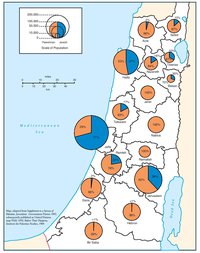
POPULATION OF PALESTINE BY SUB-DISTRICT, 1946
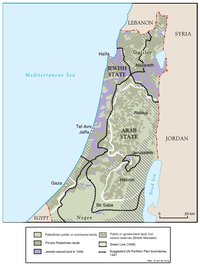
LAND OWNERSHIP IN PALESTINE, 1948
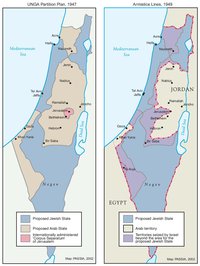
THE UNGA PARTITION PLAN, 1947 – THE 1948 WAR & THE 1949 ARMISTICE LINES
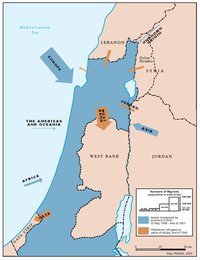
POPULATION MOVEMENTS, 1948-1951
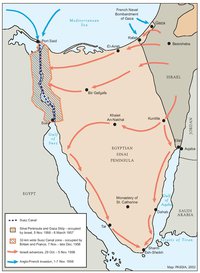
THE SUEZ WAR, 1956
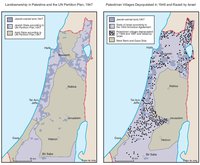
LAND OWNERSHIP IN PALESTINE AND THE UN PARTITION PLAN - PALESTINIAN DEPOPULATED AND DESTROYED VILLAGES, 1948-1949
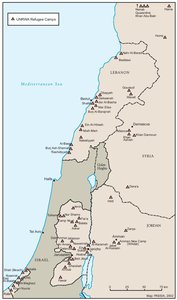
THE PALESTINIAN DIASPORA, 1958
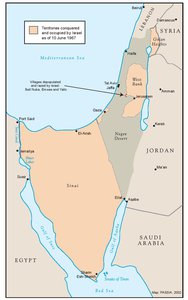
THE NEAR EAST AFTER THE JUNE 1967 WAR
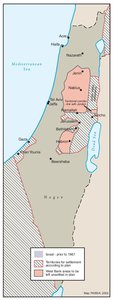
THE ALLON PLAN, JUNE 1967
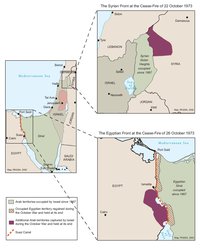
THE OCTOBER WAR, 1973
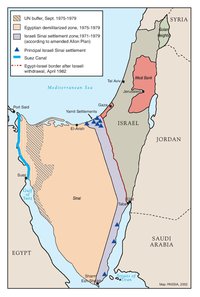
THE CAMP DAVID ACCORDS, 1978-1979
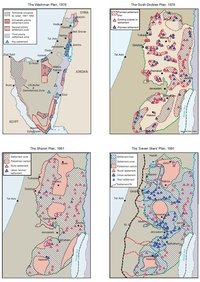
ISRAELI SETTLEMENT MASTER PLANS, 1976-1991
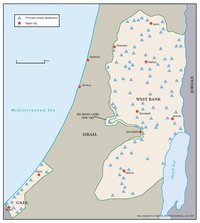
THE 1991 MADRID PEACE CONFERENCE & ISRAELI SETTLEMENTS
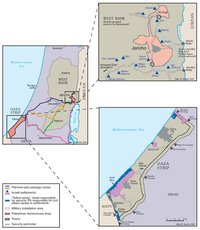
GAZA-JERICHO (OSLO I) AGREEMENT, CAIRO, 4 MAY 1994
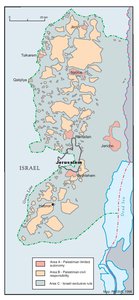
INTERIM (OSLO II) AGREEMENT, TABA, 28 SEPTEMBER 1995
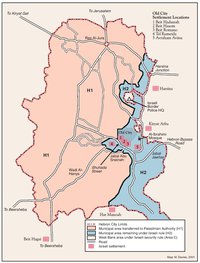
HEBRON PROTOCOL, 15 JANUARY 1997
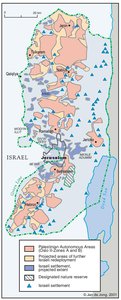
WYE RIVER MEMORANDUM, 23 OCTOBER 1998
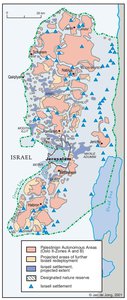
SHARM ESH-SHEIKH AGREEMENT, 4 SEPTEMBER 1999
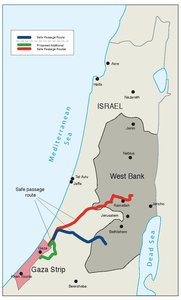
PROTOCOL CONCERNING SAFE PASSAGE BETWEEN THE WEST BANK AND THE GAZA STRIP, 5 OCTOBER 1999
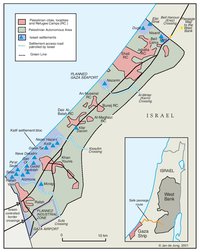
GAZA, 2000
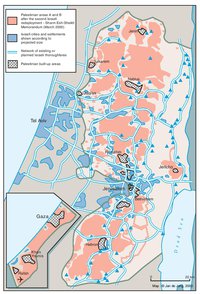
WEST BANK AND GAZA STRIP, MARCH 2000
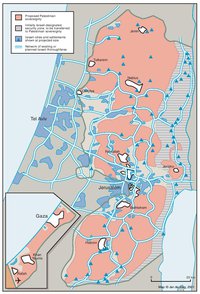
CAMP DAVID PROJECTION, JULY 2000
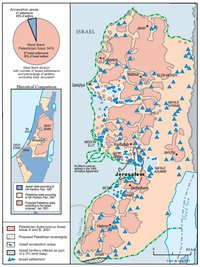
TABA TALKS PROJECTION, JANUARY 2001
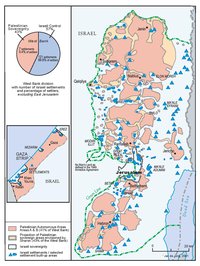
THE SHARON PROPOSAL, SPRING 2001
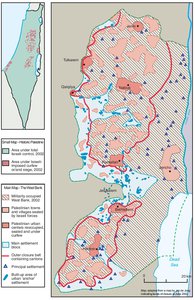
THE REINVASION OF THE PALESTINIAN TERRITORIES, 2001-2002
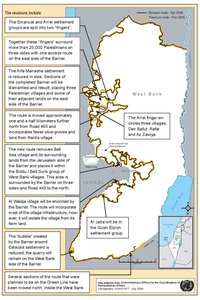
THE ROAD MAP, 2003
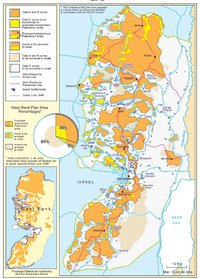
THE GENEVA INITIATIVE AND ACCORD, 2003
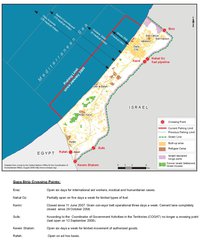
THE ISRAELI DISENGAGEMENT PLAN, 2003-2005
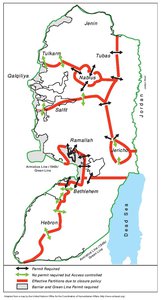
AGREED DOCUMENTS ON MOVEMENT AND ACCESS FROM AND TO GAZA, 2005
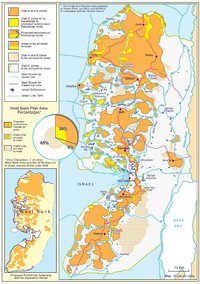
THE SETTLERS' PLAN FOR PALESTINIAN AUTONOMY, 2006
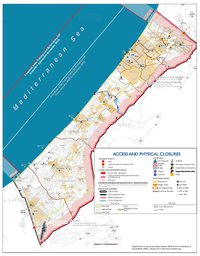
THE GAZA STRIP TODAY (2014)
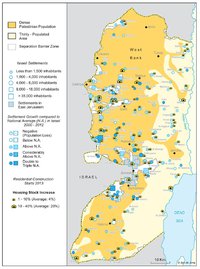
THE WEST BANK TODAY (2014)
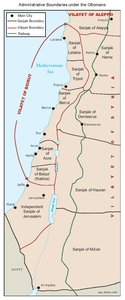
ADMINISTRATIVE BOUNDARIES
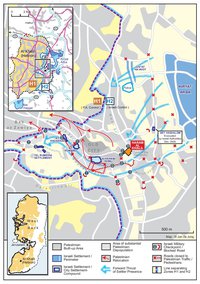
HEBRON
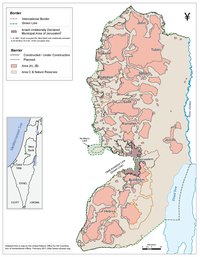
Area C
